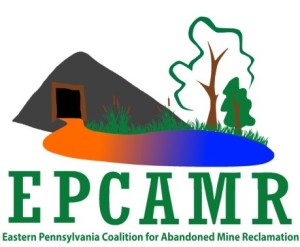
(Ashley, PA)– EPCAMR, the Eastern PA Coalition for Abandoned Mine Reclamation, Wilkes University, Misericordia University, Earth Conservancy, and Greater Nanticoke Area Elementary (GNA) have partnered for an Environmental Education Outreach and Pottery Art Program to teach students about abandoned mine drainage (AMD) water pollution problems in the Southern Wyoming Valley watersheds and how those pollution sources can be solved in creative ways reusing one of the by-products of past mining practices. EPCAMR, who specializes in restoring streams impacted by AMD, conducting community cleanups, and providing education and outreach efforts to many regional schools throughout the Coal Region recently received a $3000 environmental education grant through the PA Department of Environmental Protection’s Environmental Education Grant Program in order to fund our project through the Summer of 2015. EPCAMR has purchased two pottery wheels, clay, and supplies to support the project.
EPCAMR will be taking the entire 4th & 5th grade classes from GNA to multiple AMD impacted sites within the School District and in S. Wilkes-Barre. Seven field trips are planned that will allow students to experience where the iron oxide comes from before heading to EPCAMR to see how iron oxide can be processed and re-used in art projects. The iron oxide can be used for painting, tie-dying, making chalk, and creating pottery glazes. EPCAMR, with the help of Jean Adams of Wilkes University & Skip Sensbach of Misericordia University, both Artists and Professors who will be teaching the students at GNA how to create pottery and use reclaimed iron oxide in order to create sustainable art. GNA’s Mrs. Michelle Kordek, is assisting with the coordination of the project with EPCAMR, both inside and outside of the classroom. The students will be creating art after the Winter Christmas Break in early 2015 in their art classroom where they will be dipping their pottery that they create in one of several iron oxide glazes that will be mixed by EPCAMR and the Artists. EPCAMR plans to create its very own regional glaze mixture of iron oxide by the end of the project.
EPCAMR’s Executive Director and local resident of Nanticoke, Robert Hughes, who has worked previously with the Greater Nanticoke Area to bring grants and outdoor environmental education programs to the District over the last 8 years is happy to be able to bring this type of interdisciplinary education approach to the 4th and 5th grade students at GNA. He goes on to say:
“I really think that our students need to gain an understanding of the local world around them and the impacts that it is having on them directly or indirectly, whether or not they know what those problems are at this point in their young lives or not. By having our regional non-profit organization bring the students out into the surrounding local streams and watersheds that are within two miles of their own backyard and school to learn about the environmental impacts to our community is something that they should at least be aware of as they get older. They should understand why their rivers and streams are orange, smell like sulfur, where this mine water is coming from, and what can be done and is being done to clean it up. They should learn that they can become a part of the solution and become actively engaged in local stream cleanups or illegal dump site cleanups that EPCAMR has already coordinated within the School District and greater Southern Wyoming Valley. Those students who might want to become artists will also have another outlet and medium to work in once we show them how to recycle the iron oxide from these mine discharges that can be used for multiple art mediums in the classroom. These are just some of the reasons why I’ve decided to pursue this grant and was successful in having our organization receive the innovative grant award to serve our community first. I want my hometown to be the first School District to have the opportunity to utilize our regional iron oxide glazes that we will be creating and using in the classroom when we create some pottery art next year.”
The AMD Field Tours are going to be in the mornings from around 8am-12 noon on the following dates: November 21, November 24, November 25, November 26, December 2, December 3, and December 5.
Abandoned mine drainage (AMD) is caused by a reaction between pyrite, fool’s gold, and the oxygen present in the water. The result is a thick orange sediment which coats the stream bottom and makes it difficult for native plants and animals to live in the water. 5500 miles of streams in PA are polluted by AMD. www.epcamr.org
Abandoned Mine Drainage (AMD) Environmental Education
& Pottery Art Program Tour Agenda (Leave from GNA Elementary Center around 8AM)
Abandoned Mine Drainage (AMD)
– Pollutant that occurs as a result of past coal mining practices
– AMD forms when water from underground mines mixes with pyrite (fool’s gold) and oxygen to form rust
– The result is an orange muck which settles on the bottom of rivers and streams and pollutes the water and makes it hard for plants & animals to survive.
Site 1: Red Lake
– Former Stripping Pit and municipal landfill at the far end of the pit looking north for the Glen Nan Colliery
– Orange/Red coloration from AMD upwelling into the stripping pit
– 20 acre lake bubbles and gurgles as water rushes into the lake from seeps and old mine gangways along the easterly portion of the stripping pit
– AMD from Red Lake meets up with the Honey Pot Discharge (Site #2)
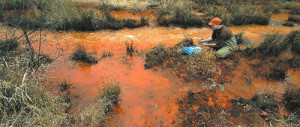
Robert Hughes, Executive Director of Eastern PA Coalition for abandoned mine reclamation, takes water samples in mine drainage in Newport Township, Luzerne County, below Red Lake- (Michael J. Mullen)
Site 2: Honey Pot Discharge
– Discharges from an abandoned air shaft (#7) from the former Susquehanna #7 Colliery
– Was once the slackwater section for the Susquehanna North Branch Canal. Boats would come along the canal near Access Road to be loaded with coal.
– 2000 gal/minute average flow with high iron loading that eventually reaches the Newport Creek and Susquehanna River
– Where EPCAMR get most of our iron oxide
– Have students assist with getting iron oxide
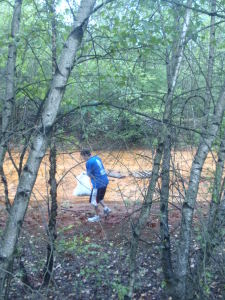
Wilkes University Volunteer cleaning up trash along the Honey Pot AMD discharge near the LCCC Park-n-Ride.
Site 3: Solomon Creek Boreholes
– 6 Boreholes (5 new & 1 old), 2 old ones collapsed and were replaced with 5 new ones
– Third largest borehole drainage area in the region
– 20 million gallons of water per day
– Boreholes are 240 feet deep

Solomon Creek AMD Boreholes in South Wilkes-Barre
Site 4: Askam Borehole AMD Treatment System (20 minutes)
– Askam Borehole drilled in the 1970’s to relieve water pressure from underground mines causing water to go into residential basements;
– Collapsed in 1998 and two new boreholes had to be drilled on the other side of Dundee Road in between SR 29 and along the streambank of Nanticoke Creek
– Askam Treatment System uses the Maelstrom Oxidizer which uses a series of tubes which push air into the water and cause the iron to fall out, making the water cleaner as it enters back into Nanticoke Creek following the dropping out of the iron in the series of ponds and baffles used to slow down the water
– 3500 gal/minute into system
– Have students monitor water level (depth to the mine pool) at the Borehole with the Solonist Tape
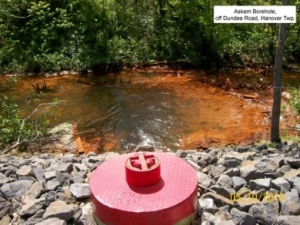
Askam AMD Borehole along Dundee Road.
Site 5: EPCAMR Office
– Show students iron oxide station and examples of reuse of the pigment for various products
– Iron Oxide Solar Kiln for Drying and Processing AMD and converting into iron oxide packets for sale
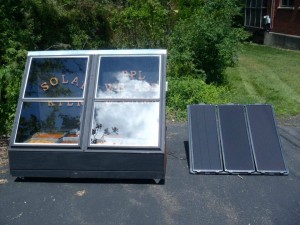
EPCAMR AMD Solar Kiln












You must be logged in to post a comment.